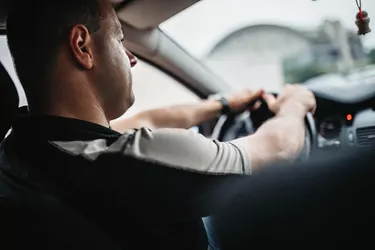
It's not uncommon for an auto insurance company to write a check for a claim to two separate entities. The car insurance check will almost certainly be made out to you and the lienholder if you have an unpaid loan against the car. This type of check is referred to as a "two-party" insurance check. Some rules apply to cashing one, and disregarding the rules can result in financial and even legal penalties.
Two-Party Insurance Checks
Video of the Day
Don't blame your insurance company for putting your lender's name on that check. The company has a legal obligation to include both of you as payees because you both have a financial stake in the vehicle if it hasn't been paid off yet. The loan you took forms a lien against the car, allowing the lender to repossess the vehicle and sell it if you don't make payments and to share in that check. The insurance check will be made out to you and the bank that financed the car.
Video of the Day
Who Has to Endorse the Check?
The issue becomes further complicated because two-party checks can be written in one of two ways. Both names will appear on the "pay to the order" line, but there should be a pivotal word between those two names – "and" or "or."
Both you and your lienholder must endorse the check if the word "and" appears there. Depending on the size of the check, a bank might require both you and a representative of the lienholder to jointly present it for payment, along with government ID to prove your identities.
Only one of you needs to sign the check if it says "or," and you're probably safe in just signing it yourself if the two names show up on that line without a qualifier. It's not unequivocally telling you that both parties must sign the check.
Who Gets the Money?
The check can be deposited in either payee's account regardless of whether it says "and" or "or," assuming that both parties have signed it. But you probably won't have much luck if it says "and" and you try to cash it.
In either case, you have no choice but to reach out to your lienholder if the check says "and" so you can get a signature. You can turn the check over to them along with a copy of the repair estimate and ask the lender to make its own check out for the cost of repairs. Anything left over would likely be applied to your loan balance.
You might also send the check back to the insurance company if it says "and," requesting that they make the check out to the auto repair shop instead. The shop will send any balance that's left over to your lienholder and that money should be applied to your loan just as if you had sent the check to the lender.
Still another option is that the auto repair shop might accept the check with just one signature because they're legally obligated to send any unused funds back to the insurance company anyway. But not all shops will be this obliging because there could be legal ramifications if the check is misplaced or misused.
If You Don’t Want the Repairs
All this assumes that your vehicle isn't totaled, or that you don't mind driving around in a car with dents, dings or crushed fenders. In either case, you might be able to sign the check if it's made out to you "and" your lienholder, send it to your lienholder and ask that it be applied to your loan balance in its entirety because you don't want to fix the vehicle.
Your odds of success with this option are better if the car is a total loss. Otherwise, your lender is probably going to want its asset to be restored to decent, sellable shape.